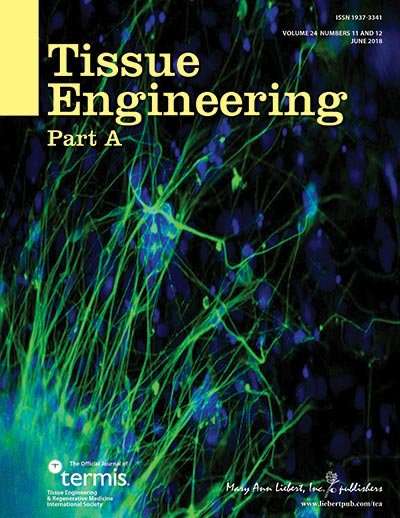Tissue Engineering brings together scientific and medical experts in the fields of biomedical engineering, material science, molecular and cellular biology, and genetic engineering. Credit: Mary Ann Liebert, Inc., publishers
Researchers have demonstrated that a novel biocompatible adhesive made of two naturally derived polymers is 15 times stronger than adhesive materials currently used for nerve reconstruction and can support the survival, extension, and proliferation of cells essential for nerve regeneration. The study showing the regenerative potential of this new hydrogel adhesive in vitro and when implanted in a mouse model of suture-less repair of sciatic nerves is published in Tissue Engineering, Part A.
Ryan Koppes, Northeastern University (Boston, MA), Nasim Annabi, Northeastern U. and Massachusetts Institute of Technology (Cambridge, MA), and coauthors from Tecnológico de Monterrey (Mexico) and University of Sydney (Australia) describe the materials and technique they developed in the article entitled "Photocrosslinkable Gelatin/Tropoelastin Hydrogel Adhesives for Peripheral Nerve Repair." The researchers used photocrosslinking to combine two polymers with distinct biophysical and biochemical characteristics to form the adhesive hydrogel. This produced a material with improved adhesive strength compared to conventional fibrin-based adhesives, and with the desired mechanical stability, nerve regenerative capability, and biodegradable and immunogenic properties.
"This article presents the development of a regenerative biomaterial that has designer mechanical properties and adhesive characteristics and addresses an important clinical need for nerve regeneration," says Tissue Engineering Co-Editor-in-Chief Antonios G. Mikos, Ph.D., Louis Calder Professor at Rice University, Houston, TX.
More information: Jonathan R. Soucy et al, Photocrosslinkable Gelatin/Tropoelastin Hydrogel Adhesives for Peripheral Nerve Repair, Tissue Engineering Part A (2018). DOI: 10.1089/ten.tea.2017.0502
Provided by Mary Ann Liebert, Inc
























